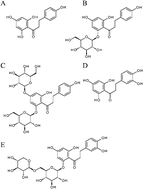Apple procyanidins affect several members of the ErbB receptor tyrosine kinase family in vitro
Abstract
Complex

Maintenance work is planned from 09:00 BST to 12:00 BST on Saturday 28th September 2024.
During this time the performance of our website may be affected - searches may run slowly, some pages may be temporarily unavailable, and you may be unable to access content. If this happens, please try refreshing your web browser or try waiting two to three minutes before trying again.
We apologise for any inconvenience this might cause and thank you for your patience.
* Corresponding authors
a
Department of Food Chemistry and Toxicology, University of Vienna, Waehringer Strasse 38, 1090 Vienna, Austria
E-mail:
doris.marko@univie.ac.at
Fax: +43-1-427770899
Tel: +43-1-427770800
b University of Karlsruhe (TH), Institute of Applied Biosciences, Section of Food Toxicology, Adenauerring 20, 76131 Karlsruhe, Germany
c University of Kaiserslautern, Faculty of Chemistry, Division of Food Chemistry and Toxicology, Erwin-Schroedinger-Strasse 52, 67663 Kaiserslautern, Germany
d Department of Wine Chemistry and Beverage Technology, Research Center Geisenheim, von-Lade-Strasse 1, D-65366 Geisenheim, Germany
e University of Strasbourg, Unit EA 4438, Laboratory of Nutritional Cancer Prevention, IRCAD 1 place de l’hôpital, F-67091 Strasbourg, France
f University of Wuerzburg, Am Hubland, 97074 Wuerzburg, Germany
Complex

 Please wait while we load your content...
Something went wrong. Try again?
Please wait while we load your content...
Something went wrong. Try again?
N. Teller, M. Roth, M. Esselen, D. Fridrich, U. Boettler, V. Blust, F. Will, H. Dietrich, F. Raul, W. Hümmer, E. Richling, P. Schreier and D. Marko, Food Funct., 2013, 4, 689 DOI: 10.1039/C3FO30166D
To request permission to reproduce material from this article, please go to the Copyright Clearance Center request page.
If you are an author contributing to an RSC publication, you do not need to request permission provided correct acknowledgement is given.
If you are the author of this article, you do not need to request permission to reproduce figures and diagrams provided correct acknowledgement is given. If you want to reproduce the whole article in a third-party publication (excluding your thesis/dissertation for which permission is not required) please go to the Copyright Clearance Center request page.
Read more about how to correctly acknowledge RSC content.
 Fetching data from CrossRef.
Fetching data from CrossRef.
This may take some time to load.
Loading related content
